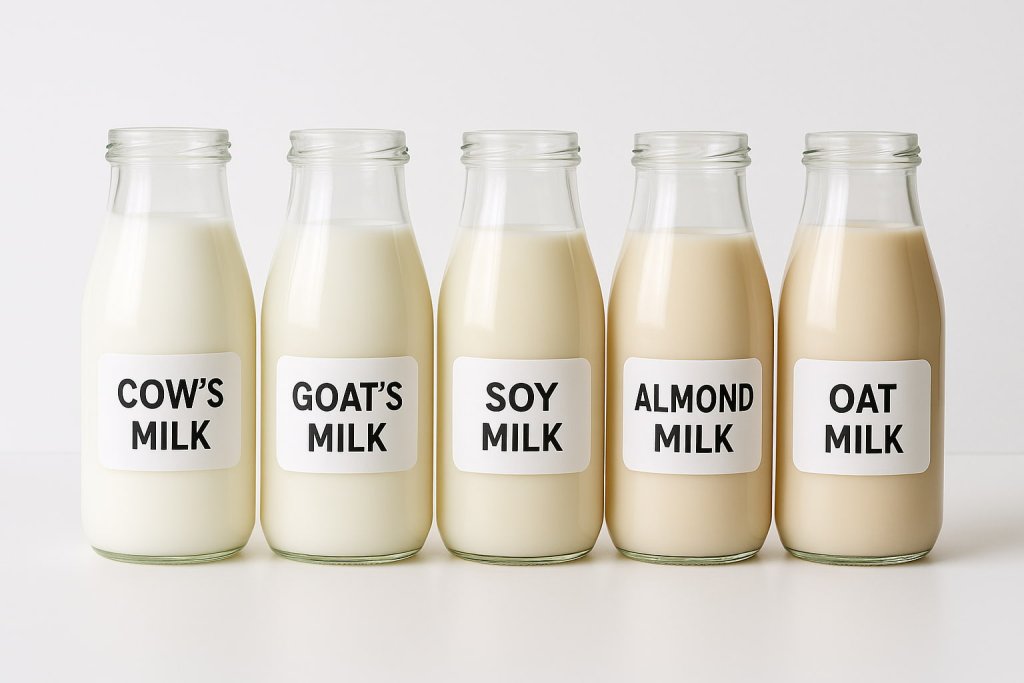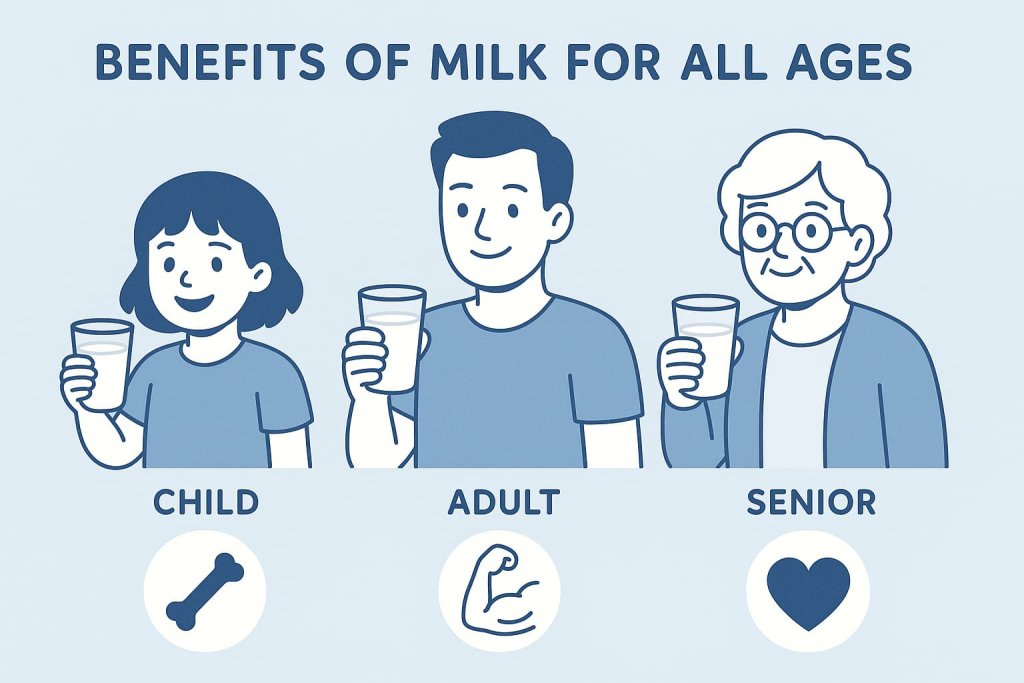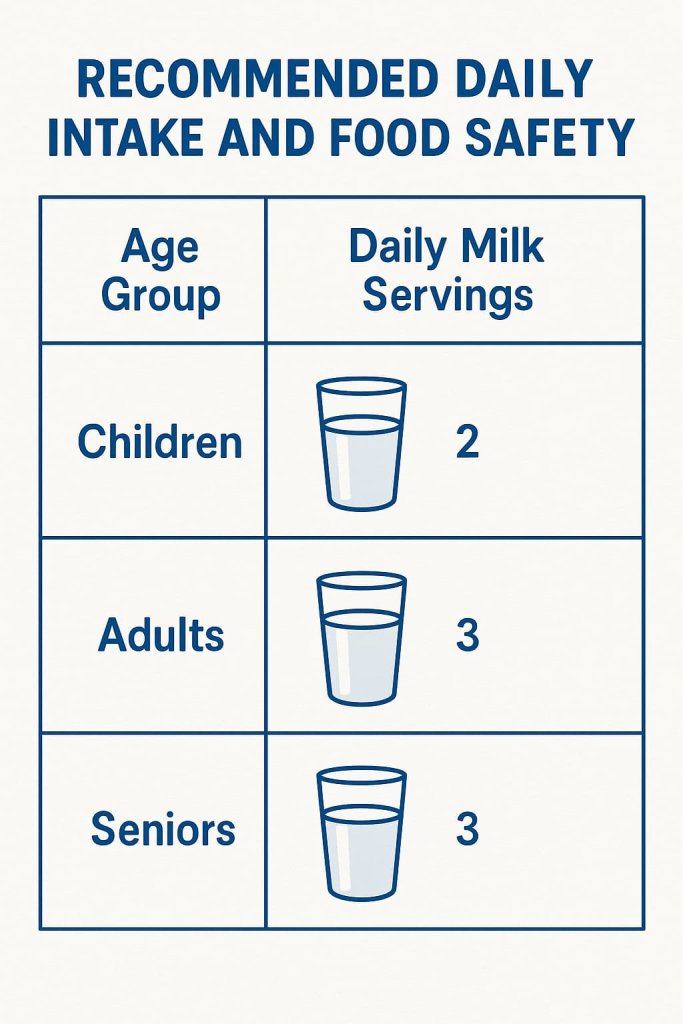The benefits of milk for all ages are well-documented in nutrition science. Milk supports overall wellness by providing essential nutrients such as calcium, protein, vitamin D, potassium, and B vitamins, which contribute to bone strength, muscle maintenance, and metabolic health.

From childhood growth to healthy aging, milk plays a valuable role in maintaining nutrient balance when included as part of a varied, balanced diet. It offers complete proteins and bioavailable minerals that may help support strong bones, healthy muscles, and overall vitality.
Understanding the importance of milk in daily nutrition is essential because it remains one of the most accessible and nutrient-dense foods across the globe. Whether consumed as part of breakfast, a recovery drink, or paired with fortified alternatives like soy or oat milk, it can fit easily into diverse dietary patterns.
In this article, you’ll discover how milk supports health across every life stage, its nutritional composition, and practical, science-backed guidance on recommended intake, safety, and alternatives — helping you make informed, balanced, and confident dietary choices.
What Is Milk and Why It Matters for All Ages
Milk is a nutrient-dense natural food produced by mammals to nourish their young. In human diets, it most commonly refers to cow’s milk, though goat milk and fortified plant-based alternatives (like soy, oat, or almond milk) are also widely consumed. Each type offers distinct nutritional benefits, but cow’s milk remains a key dietary source of high-quality protein, calcium, and other essential nutrients.
According to the Harvard T.H. Chan School of Public Health, milk provides a unique combination of macronutrients and micronutrients in a form that is easily absorbed by the body. It contains all three macronutrients — protein, fats, and carbohydrates — along with vital minerals such as calcium, phosphorus, and potassium, and vitamins including B12, riboflavin, and vitamin D (in fortified versions).

Why Milk Matters Across the Lifespan
- For children and teens: Milk supplies the building blocks for growth — its calcium, phosphorus, and protein content may support bone and muscle development.
- For adults: Regular milk intake can contribute to maintaining lean muscle, balanced weight, and sufficient calcium and potassium for cardiovascular health.
- For older adults: Milk helps fill nutrient gaps that often occur with age, supporting bone density and muscle preservation.
Globally, milk remains part of most dietary guidelines because of its nutrient density and accessibility. The U.S. Department of Agriculture (USDA) Dietary Guidelines for Americans 2020–2025 recommend low-fat or fat-free dairy — including milk — as part of a balanced diet for both children and adults. Fortified plant-based alternatives (such as fortified soy beverages) are recognized as suitable substitutes for individuals with lactose intolerance or dairy allergies, provided they contain comparable levels of protein, calcium, and vitamin D.
In short, milk’s nutritional versatility makes it relevant at every age — from early growth through active adulthood to healthy aging — as part of a diverse, balanced eating pattern.
Nutritional Profile of Milk
Milk is valued for being a complete food, meaning it provides a balance of energy, protein, fats, and essential micronutrients. Below is a detailed breakdown of the nutrients typically found in one cup (240 mL) of 2% cow’s milk, based on data from the USDA FoodData Central.
| Nutrient (per 240 mL) | Approx. Amount | Key Function in the Body |
|---|---|---|
| Calories | ~122 kcal | Provides energy for daily metabolism |
| Protein | 8.0 g | Supplies complete amino acids for muscle growth and repair |
| Fat | 4.8 g | Source of essential fatty acids and fat-soluble vitamins |
| Carbohydrates (Lactose) | 12 g | Natural milk sugar providing steady energy |
| Calcium | 305 mg (23–25% DV) | Supports bone and teeth structure, muscle function |
| Phosphorus | 233 mg (18% DV) | Works with calcium for bone mineralization |
| Potassium | 366 mg (8% DV) | Helps maintain normal blood pressure |
| Magnesium | 27 mg (6% DV) | Supports nerve function and energy metabolism |
| Vitamin B12 | 1.1 µg (46% DV) | Vital for red blood cell formation and brain function |
| Riboflavin (B2) | 0.4 mg (31% DV) | Converts food into energy and supports skin health |
| Vitamin A | 112 µg RAE (12% DV) | Essential for vision and immune function |
| Vitamin D (fortified) | 2.9 µg (15% DV) | Aids calcium absorption and bone health |
Source: USDA FoodData Central, 2024
Key Takeaways
- Milk provides high-quality complete protein, containing all nine essential amino acids, making it beneficial for muscle and tissue maintenance.
- It is one of the most accessible dietary sources of calcium and vitamin D, nutrients crucial for bone density and growth.
- The potassium-to-sodium ratio in milk may help support normal blood pressure levels.
- Fortified plant-based alternatives — particularly soy milk — can offer similar nutrients when fortified with calcium, vitamin D, and B12, as noted by the National Institutes of Health Office of Dietary Supplements (NIH ODS).
Including milk (or fortified alternatives) in moderation as part of a varied diet can help individuals of all ages meet daily nutrient requirements, supporting bone, muscle, and metabolic health.
Benefits of Milk for All Ages

Milk is one of the most nutrient-dense beverages available and can play a beneficial role in nutrition throughout life. From supporting growth in children to maintaining muscle and bone health in adults and older individuals, milk’s balanced combination of protein, vitamins, and minerals contributes to overall wellness. Below is a detailed life-stage breakdown of how milk consumption may support health based on current scientific evidence.
Children and Adolescents

During childhood and adolescence, rapid growth increases the body’s demand for essential nutrients such as calcium, phosphorus, and protein. Milk provides these in a balanced and highly bioavailable form, making it a cornerstone food for growth and development.
- Bone and muscle development: Milk is rich in high-quality protein and calcium, which may support bone mineralization and muscle formation during growth spurts. A 2020 review published in the National Center for Biotechnology Information (NCBI) found that regular milk consumption during early life is associated with improved bone mass and overall growth outcomes (NCBI, PMC5122229).
- Healthy weight and metabolism: A meta-analysis of observational studies found that children and adolescents who consumed more dairy foods—including milk—had a lower risk of overweight and obesity compared to those with minimal intake (NCBI, PMC5122229). The proteins and fats in milk may help increase satiety, reducing the likelihood of excess calorie intake from less nutritious foods.
- Nutrient adequacy: Many children fall short on nutrients such as calcium, potassium, and vitamin D. Milk helps fill these nutritional gaps, as one cup provides significant portions of the daily recommended intake for these nutrients (Harvard T.H. Chan School of Public Health).
In short, milk supports children’s growth, bone density, and healthy body composition when included as part of a balanced diet rich in whole foods.
Adults (Young and Middle Age)

For adults, milk continues to be a valuable contributor to daily nutrient intake, particularly for maintaining lean muscle, bone integrity, and metabolic balance.
- Muscle and metabolic health: Each cup of milk delivers about 8 grams of complete protein, providing both whey and casein—two proteins known to support muscle repair and maintenance. Studies have shown that adults who include milk or dairy in their diet may have better body composition and improved weight control (Harvard T.H. Chan School of Public Health).
- Reduced risk of metabolic syndrome and type 2 diabetes: A 2020 umbrella review published in Nutrition & Metabolism found that individuals with higher milk intake had a 16% lower risk of obesity and a reduced likelihood of developing metabolic syndrome and type 2 diabetes for each additional 200 grams of milk consumed daily (BioMed Central, Nutrition & Metabolism).
- Heart and vascular support: The same review noted a 7% lower stroke risk with each additional 200 grams of milk intake per day, likely due to milk’s potassium and magnesium content, which may help support healthy blood pressure regulation (NCBI, PMC5122229).
For adults, milk can be a simple and effective way to maintain energy, protein intake, and cardiovascular balance—especially when paired with a diet rich in fruits, vegetables, and whole grains.
Older Adults (Senior Years)

As we age, our bodies undergo physiological changes that increase the need for certain nutrients—while appetite and absorption often decline. Milk can help older adults meet these essential nutrient requirements and support overall wellness.
- Bone and muscle maintenance: Older adults are more susceptible to bone loss and sarcopenia (age-related muscle loss). Milk provides calcium, protein, and phosphorus—key nutrients for maintaining bone mineral density and muscle strength. Research from the Harvard T.H. Chan School of Public Health notes that milk is a reliable source of these nutrients and may support musculoskeletal health in aging populations (Harvard Nutrition Source).
- Vitamin D and calcium synergy: In regions where milk is fortified with vitamin D, it may help enhance calcium absorption and contribute to maintaining bone integrity and immune function (National Institutes of Health, Office of Dietary Supplements).
- Dietary adequacy: According to the Cleveland Clinic, incorporating milk or fortified milk alternatives can help meet daily protein, calcium, and vitamin D needs—especially for those who consume limited food volumes or have difficulty chewing (Cleveland Clinic, 2024).
While milk alone cannot prevent conditions like osteoporosis, it can be part of a dietary strategy that supports bone and muscle health when combined with physical activity, adequate sunlight exposure, and a nutrient-rich diet.
Summary Insight
Across all age groups, milk functions as a nutrient powerhouse—offering a mix of macronutrients and micronutrients that support bone, muscle, and metabolic health. Its versatility and nutrient density make it an efficient dietary component for individuals who tolerate dairy. However, those with lactose intolerance or milk allergies should choose lactose-free or fortified plant-based alternatives that provide similar nutrient levels in calcium, vitamin D, and protein.
By consuming milk mindfully and in moderation, individuals can enjoy its nutritional benefits as part of an overall healthy and balanced eating pattern.
How to Include Milk in a Balanced Diet

Incorporating milk into your daily diet can be simple and effective for supporting nutrient balance. Milk complements most eating patterns — whether traditional, Mediterranean, or plant-forward — and can be adapted to suit individual needs and tolerances.
Daily Servings and Portion Guidance
The U.S. Department of Agriculture (USDA) Dietary Guidelines for Americans 2020–2025 recommend 2–3 servings of dairy per day for most individuals. One serving is typically:
- 1 cup (240 mL) of milk
- 1 cup of fortified soy beverage
- 1½ ounces of natural cheese or 2 ounces of processed cheese
These portions supply essential nutrients like calcium, protein, and vitamin D that support bone, muscle, and metabolic health.
Smart Ways to Pair Milk with Meals
- At breakfast: Add milk to oatmeal, cereal, or coffee for protein and calcium.
- As a snack: Combine milk with fruit, nuts, or whole-grain toast for a nutrient-balanced mini meal.
- Post-workout recovery: A glass of milk may support muscle repair thanks to its unique blend of whey and casein proteins (Cleveland Clinic, 2024).
- In cooking: Use milk in soups, sauces, smoothies, or baked goods to boost nutrient density.
Choosing the Right Type of Milk
- Low-fat or fat-free milk: Recommended for individuals managing calorie or saturated-fat intake.
- Whole milk: Offers higher energy and fat-soluble vitamins for growing children or those needing more calories.
- Lactose-free milk: A good choice for people with lactose intolerance — it provides the same nutrients without discomfort.
- Fortified plant-based milks: Options like fortified soy, oat, or almond milk can be suitable substitutes if enriched with calcium, vitamin D, and B12. According to the Harvard T.H. Chan School of Public Health, fortified soy milk most closely matches cow’s milk nutritionally.
In every case, prioritize unsweetened and fortified varieties to avoid added sugars and ensure nutrient adequacy.
Possible Side Effects and Precautions
While milk offers many nutritional benefits, some individuals should moderate or tailor their consumption due to sensitivities, allergies, or health risks. Maintaining balance and awareness helps ensure milk remains a safe part of a healthy diet.
1. Lactose Intolerance
People who lack the enzyme lactase may experience bloating, gas, or diarrhea after consuming milk. In these cases, lactose-free milk or fortified non-dairy alternatives are good options. The National Institutes of Health (NIH) notes that most individuals with lactose intolerance can still tolerate small amounts of milk with meals or choose lactose-free versions.
2. Dairy Allergies
A milk allergy is an immune reaction to milk proteins—mainly casein and whey—and differs from lactose intolerance. According to the American College of Allergy, Asthma & Immunology (ACAAI), symptoms may include hives, swelling, vomiting, wheezing, or in severe cases, anaphylaxis. Individuals with confirmed milk allergies should avoid all milk and dairy-derived ingredients and carefully check food labels. To maintain nutrition, choose fortified non-dairy alternatives such as soy, oat, or almond milk to replace calcium and vitamin D. Those with severe reactions should work with an allergist and carry epinephrine for emergency use under medical supervision.
3. Saturated Fat and Heart Health
Whole milk contains higher saturated fat, which, in excess, may influence LDL (“bad”) cholesterol. The Harvard Health Publishing recommends choosing low-fat or fat-free milk for those concerned about cardiovascular health, as these provide the same nutrients with less saturated fat.
4. Prostate Cancer Risk Evidence
Some studies have observed an association between very high dairy intake and prostate cancer risk, though findings remain inconclusive. The Harvard Nutrition Source and NIH emphasize moderation — not elimination — as current data do not prove causation.
5. Ethical or Individual Preferences
Those following vegan, environmental, or religious dietary practices can meet nutrient needs through fortified soy or plant milks, tofu, leafy greens, and other calcium-rich foods. The USDA recognizes fortified soy beverages as nutritionally comparable to milk in balanced diets.
In summary, milk remains safe for most individuals, but personal tolerance, health goals, and ethical choices should guide consumption decisions.
Recommended Daily Intake and Food Safety

Maintaining the right serving sizes and handling milk safely are essential for preserving its nutritional benefits and preventing foodborne illness. These recommendations are based on the U.S. Department of Agriculture (USDA) Dietary Guidelines for Americans 2020–2025 and the U.S. Food and Drug Administration (FDA) Raw Milk Consumer Advisory — both authoritative and current sources as of 2025.
Recommended Daily Intake by Age
| Age Group | Recommended Milk/Dairy Servings (per day) | Source |
|---|---|---|
| 2–3 years | 2 cups (480 mL) | USDA Dietary Guidelines 2020–2025 |
| 4–8 years | 2½ cups (600 mL) | USDA |
| 9–18 years | 3 cups (720 mL) | USDA |
| Adults (19–59 yrs) | 3 cups (720 mL) | USDA |
| Adults 60+ yrs | 3 cups (720 mL) | USDA |
| Pregnant/Breastfeeding Women | 3 cups (720 mL) | USDA |
The USDA recommends two to three servings of dairy or fortified alternatives daily to help meet needs for calcium, vitamin D, potassium, and protein—nutrients that support bone strength, muscle maintenance, and metabolic function. These servings can come from milk, yogurt, cheese, or fortified soy beverages.
Food Safety Guidelines
Proper handling and storage help maintain milk’s quality and reduce foodborne illness risk.
- Choose pasteurized milk: The FDA warns that raw (unpasteurized) milk can contain harmful bacteria such as Salmonella, E. coli, and Listeria monocytogenes, which can cause serious illness, especially in children, pregnant women, and older adults.
- Keep milk refrigerated: Store milk at or below 40 °F (4 °C) and return it to the refrigerator promptly after use to prevent spoilage.
- Check freshness: Always examine the “use-by” or “sell-by” date, and discard milk that smells sour, looks clotted, or has an off taste.
- Prevent cross-contamination: Store milk in sealed containers away from raw meat, poultry, or seafood, and use clean utensils to avoid bacterial transfer.
These practices are in line with FDA Food Safety Guidelines, ensuring milk remains both safe to drink and nutritionally intact.
Frequently Asked Questions (FAQ)
Q1. Is milk good for bone health?
Yes — milk provides calcium, phosphorus, and vitamin D (in fortified varieties), which collectively support bone strength. However, bone health also depends on exercise and total diet quality (Harvard Nutrition Source).
Q2. Is plant-based milk as nutritious as cow’s milk?
Only fortified plant-based milks — especially fortified soy milk — are comparable in protein and calcium. Many nut or oat milks contain less protein and may lack vitamin D unless fortified (NIH Office of Dietary Supplements).
Q3. Can adults skip milk entirely?
Yes, adults can obtain similar nutrients from fortified foods, legumes, leafy greens, and fish with bones. Still, milk is a convenient nutrient source for those who tolerate it (Cleveland Clinic).
Q4. Does drinking more milk prevent fractures?
Not necessarily. Some large studies show mixed outcomes. Balanced calcium intake, regular activity, and vitamin D are all important for bone protection (Harvard Health Publishing).
Q5. Is raw milk healthier than pasteurized milk?
No — raw milk is not healthier and can carry harmful bacteria like Salmonella, E. coli, and Listeria. The U.S. Food and Drug Administration (FDA) and Centers for Disease Control and Prevention (CDC) warn that raw milk poses a high risk of foodborne illness. Pasteurization safely kills these pathogens without reducing milk’s nutrients, making pasteurized milk the safest, evidence-based choice for all ages.
Q6. Can milk help with muscle recovery after exercise?
Yes — milk’s natural combination of carbohydrates and complete proteins may support post-workout muscle recovery (Cleveland Clinic).
Conclusion
Milk remains one of the most nutrient-rich, accessible foods for supporting wellness across all life stages. It offers high-quality protein, calcium, and essential vitamins that may support bone density, muscle repair, and nutrient adequacy when consumed in moderation.
However, milk is not essential for everyone — balanced diets can meet similar nutrient needs through varied sources. Choosing pasteurized, low-fat, or fortified milk (dairy or plant-based) ensures both safety and nutritional value.
For those with allergies, intolerances, or ethical considerations, consult a registered dietitian to design an equivalent nutrient plan.
This content is for informational purposes only and not medical advice.
References:
